WHAT A DAY
East Coast Kayaking
By Blair Whiting
As an angler I am always dreaming of that one day when everything comes together; the big fish bite, the weather is perfect, and on top of that you put a mate onto a new PB. Well, this day was one of those days.
This summer on the Hawkes Bay coast has been spectacular, with light winds and low swell appearing on most weeks, so when my good mate Jason asked if it was worth bringing his kayak over from Manawatu, I gave him the run-down on the perfect forecast that had settled the sea and told him to pack his tuna lures – just in case.
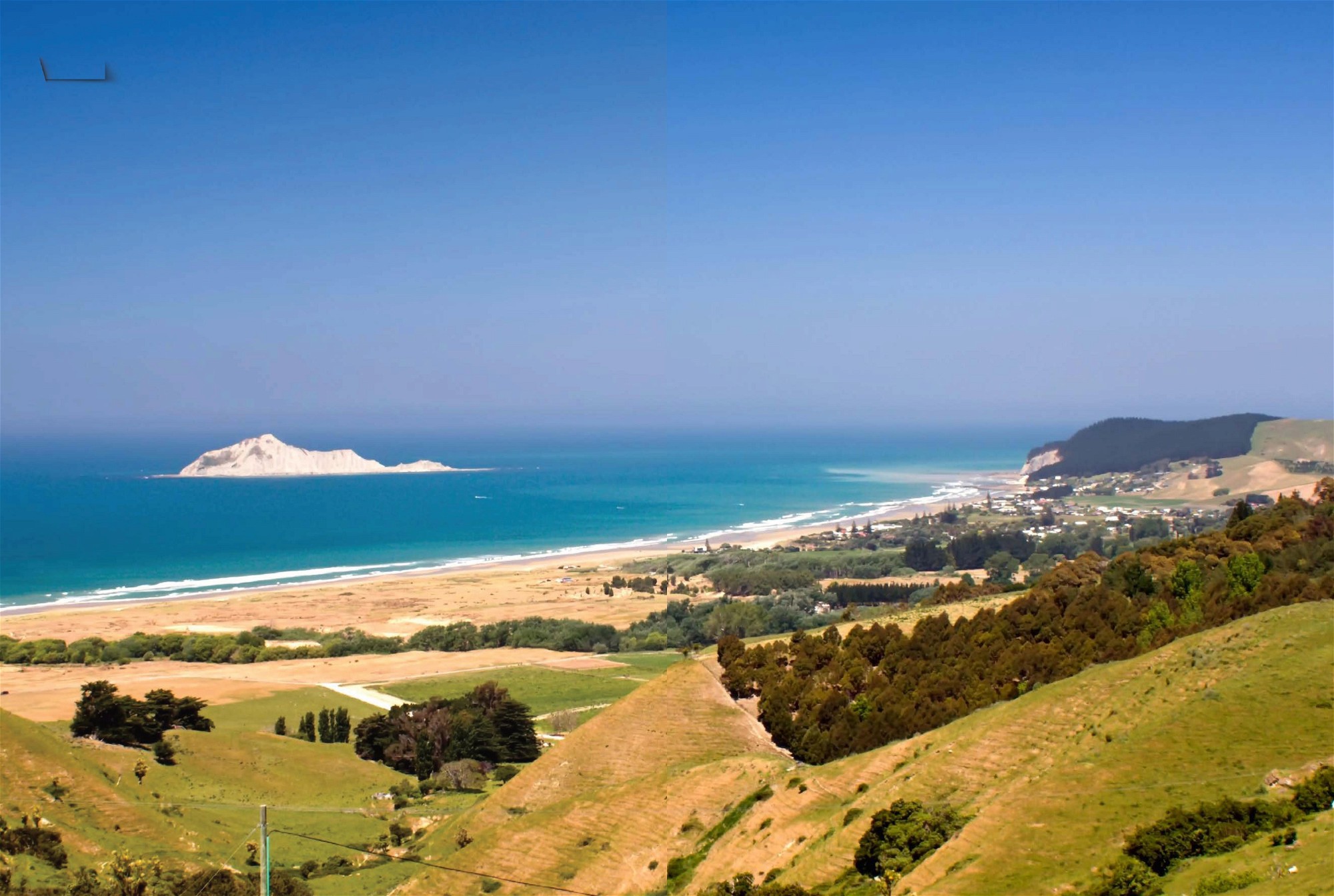
A distant view of Te Motu o Kura (Bare Island), from Waimarama Beach.
A week prior I had landed an albacore tuna, and there was a good shot at putting him onto his first tuna if the blue water was in close.
Rising bright and early, we got our gear together at the beach house, packing a large assortment and preparing for the infinite possibilities that could unfold off the Hawkes Bay coast. Jigs, kaburas, deep divers, softbaits and natural baits were all packed to cover the different situations we might run into. We kayakers love to bring far too much gear on our tiny craft.
We loaded our kitted-out kayaks onto the trailer and drove the tractor down to the local launch spot, ‘the reef’. The swell was manageable at just under one metre, and after punching through a few waves we made it out onto a glassy calm ocean.
Rods were taken out of the hull and lures were tied on before we began the 2.5km push to reach the other side of Bare Island. As we reached the island, the green water dramatically changed colour into a deep blue and the normally hidden reef could be seen down to over 10 metres. I turned to Jason and said, “We could be on for tuna here, get your deep divers out!”
Passing by the reefs, we eventually made it to 30 metres where the water colour was somehow even more perfect, and we set our lures early, knowing all too well tuna could be in this close, feeding on the surface.
The depth ticked away from 40 to 50 metres as we headed out towards a bottom spot of mine, not knowing if the tuna would be present as they can be extremely tough to locate on the best of days. Over the past month, I had worked out a method of maximising time spent in the correct area: paddle out to an area where tuna could move through during the day, drop lines down and fish on the bottom, then watch and listen for splashing fish on the surface. In such millpond conditions, sound travels a surprising distance, and it wasn’t long before we both heard the first splash of a fish up top.

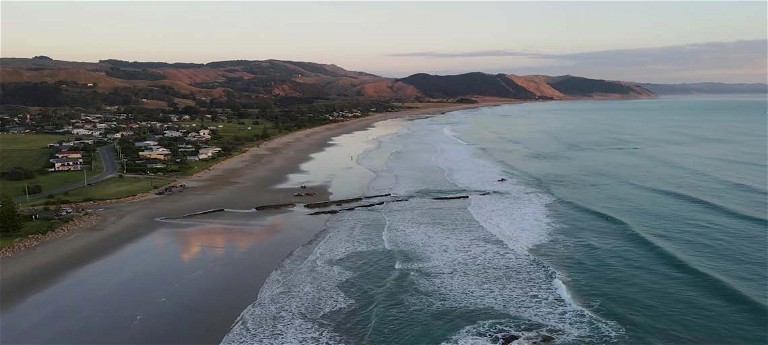

“ BIRDS BEGAN TO NOTICE THE COMMOTION AND FLOCKED TO THE AREA, BEGINNING TO FEED ON THE TINY BAITFISH THAT THE TUNA WERE FORCING TO THE SURFACE. ”
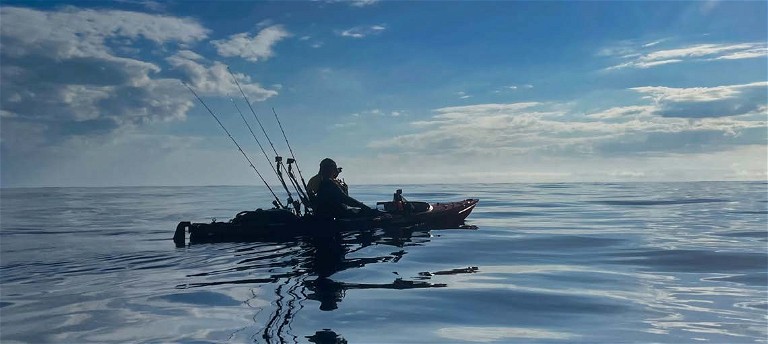
“ THIS SUMMER ON THE HAWKES BAY COAST HAS BEEN SPECTACULAR, WITH LIGHT WINDS AND LOW SWELL APPEARING ON MOST WEEKS. ”
Not being sure it was the right species, we sat in ambush, waiting to see what would develop. Hearing another big splash, I turned and looked behind the kayak, and there it was, an albacore clean out of the water. I yelled across to Jason, “Tuna! Get your lures in!”
Quickly I deployed a diver on a light 40lb fluorocarbon leader and rushed over to where I had seen the jumper. I received no hits, but just when I thought our chance had passed, both of my rods began to scream and the chaos began. Picking up the first rod, the fish promptly fell off, and then the same happened with the other. I quickly took two more paddle strokes and the disappointment quickly turned into elation as another tuna stormed in and inhaled the lure. My reel lost line at an alarming rate with the tuna outputting some serious speed. I looked up and yelled encouragement at Jason, who had just reached the area, and I watched as his rod bent right over and tore off with his first ever tuna attached.
We both yelled with excitement as we landed a couple of the toughest fish to catch off kayaks in the country, let alone off Hawkes Bay. They were lovely, fat fish around the 2.5-3kg mark. Despite being small in albacore terms, we didn’t mind at all – they had plenty of power in the tank and caused huge excitement for us fishing from kayaks. We reset and it took only seconds before I was hooked up on both rods again, with Jason following suit in short order.
Birds began to notice the commotion and flocked to the area, beginning to feed on the tiny baitfish that the tuna were forcing to the surface. I landed another brace of albacore and, with the fishing so chaotic, decided that one rod would be best after a huge tangle.
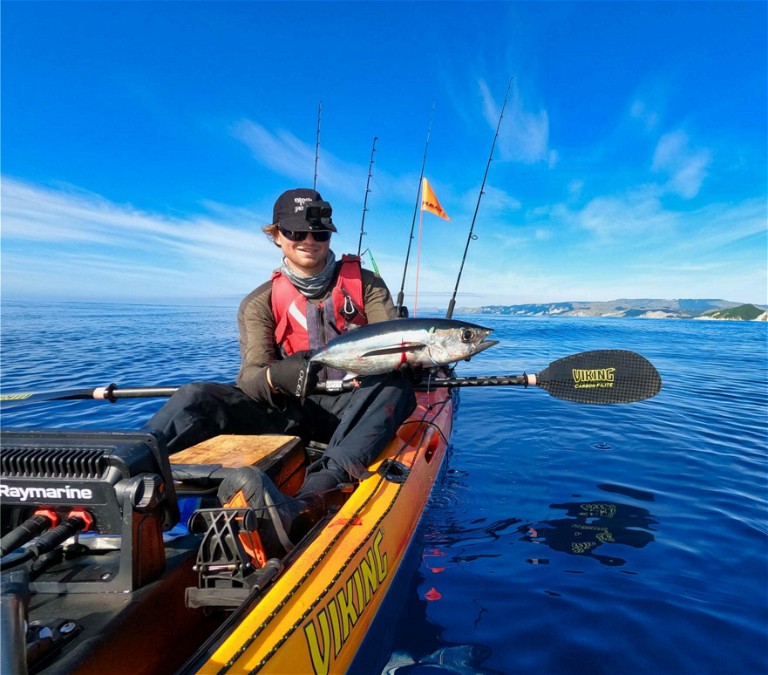
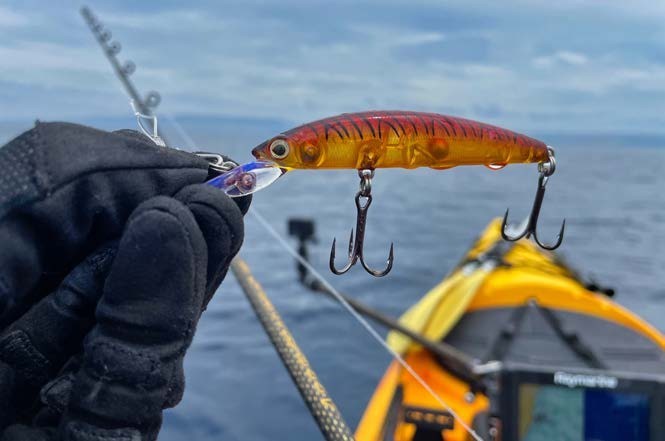
“ THE ALBACORE WERE STRAIGHT INTO IT, STRIPPING LINE OFF IN LONG BURSTS OF PURE SPEED, UNLIKE ANY OTHER FISH YOU COULD HOPE TO HOOK ON A KAYAK IN NEW ZEALAND. ”
I tied a Nomad DTX 85 lure onto my tiny little baitcaster spooled with 15lb braid and chucked that out behind me. The albacore were straight into it, stripping line off in long bursts of pure speed, unlike any other fish you could hope to hook on a kayak in New Zealand. The tiny reel and lure stood up to not one, but three more tuna, most of them let go to swim back into the baitball.
The action was spectacular, and all we could do was laugh at how much carnage was unfolding in front of us. Swapping rods again, I tied on a small 40g microjig and threw that ahead of the ‘yak to sink beneath the birds. I began a light jigging retrieve and a tuna came in and annihilated it, screaming off 50 metres of line on the strike. It was just brilliant fun, fishing with light gear on a small craft.
With our combined tally sitting on over 12 albacore and the workup moving south at pace, we reset and took a break from the carnage to drop a few kaburas down to try and pick up a few tasty bottom fish for dinner. As soon as the lures went down, gurnard were immediately into my 130g lure, with multiple fish coming from the first 30 minutes of the jigs being on the bottom. As the current took us north, a few pannie snapper joined us, along with a couple of solid gurnard up to about 1kg.
Drifting closer toward land as the depth rose and more fish showed up on the screen, my jig suddenly got struck and my kayak quickly jerked forward into a sleigh ride. For 20 minutes I battled to raise a kingfish off the bottom on 20lb braid, slowly making a dent with each turn of the reel. The stubborn fish protested the whole way, and just as I got the king 10 metres underneath the ‘yak, a mako appeared from the right, sending the kingie panicking upward to allow an easy tail grab to finish the fight. The traumatised kingfish of about 85cm was then dehooked, photographed and sent off – we were now keen to vacate the area which had a much larger predator present.
With bins full of albacore tuna, gurnard and snapper, we contemplated what to do next. The weather was still glassy and perfect. I looked at my charts and realised the current had brought us near a good rock that holds tarakihi, so we pulled up the rods and paddled over.
With a brisk current running, there was always a possibility of some kingfish being in the area, so when I went over the rock and marked a school of 15 kingfish right over the top, it was panic stations once again. We quickly geared up with jigs and I was the first to send one down. Jason then sent down a kabura and promptly got taken on a ride by a serious kingfish. It ended up breaking a new rod right at the butt – the king was such a good one the poor rod couldn’t lift it! He soon got cleaned up by another on a spin set.
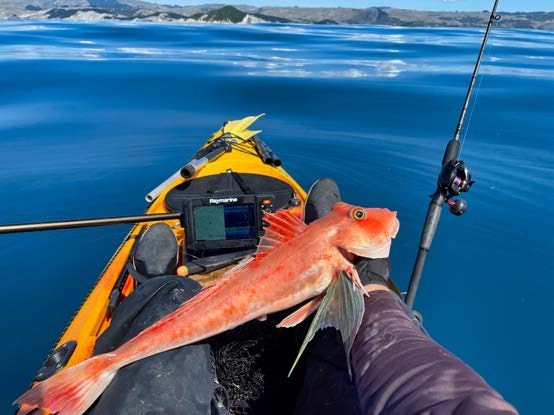
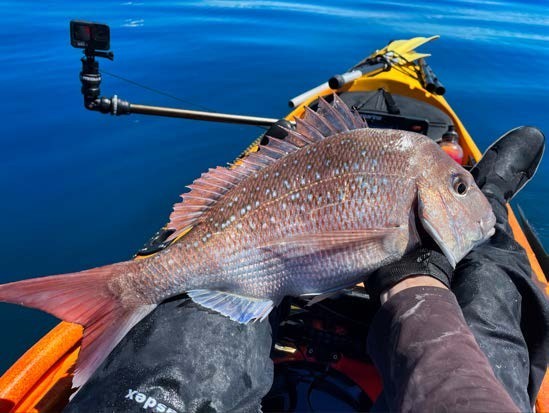
“ AS THE CURRENT TOOK US NORTH, A FEW PANNIE SNAPPER JOINED US, ALONG WITH A COUPLE OF SOLID GURNARD UP TO ABOUT 1KG. ”

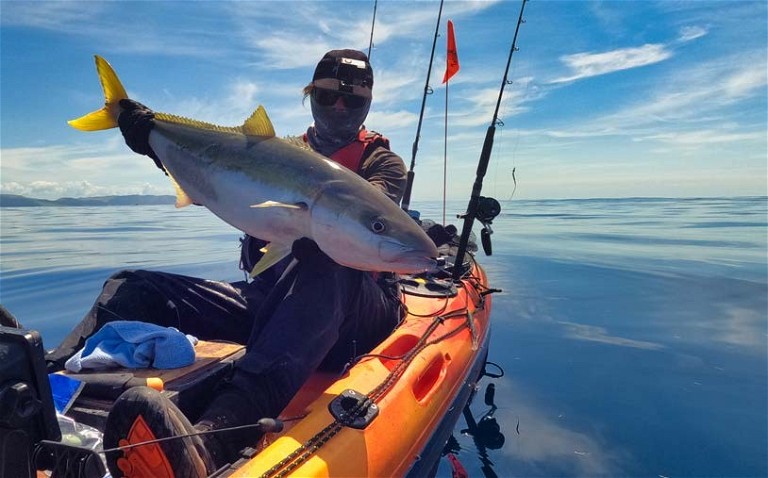
“ …WHEN I WENT OVER THE ROCK AND MARKED A SCHOOL OF 15 KINGFISH RIGHT OVER THE TOP, IT WAS PANIC STATIONS ONCE AGAIN. ”
Throughout this carnage, I couldn’t stop laughing! My mate was killing it, but as we all know kingfish are extremely tough and any weakness in the gear can end in tears.
I got on the board soon after with a feisty 85cm ‘rat’ dragged away from the rock on a 200g jig. The fish were a bit pickier after we had hooked a few, but Jason stayed persistent and got another hook-up, this time on the heavier jig gear. His arms were almost gone but patiently he worked the fish away from the bottom.
Looking underneath his ‘yak we saw a lot of colour rising from the depths, and as he finally got a hand to the fish and pulled it aboard, it was apparent that this was good enough to break his personal best off the kayak. The kingfish of 12kg was photographed and then iced down in the back of his chillpod. It’s always a good feeling when you have a kingfish tail hanging out!

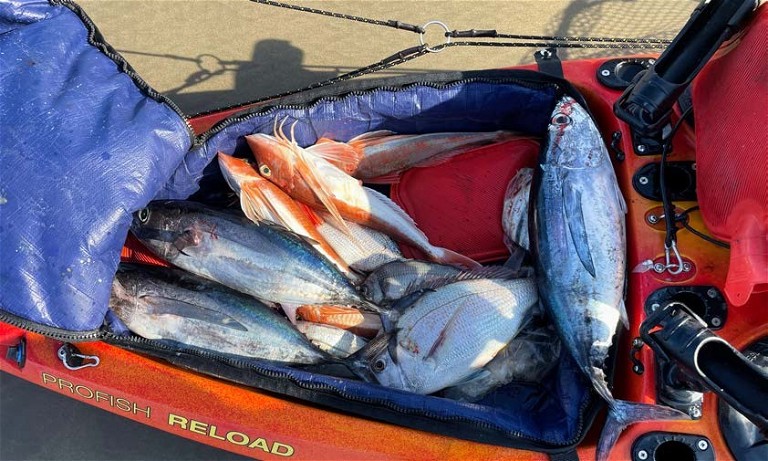
We caught a few more rat kingfish and I snagged a couple of tarakihi to round out what was the single best day of kayak fishing we both had experienced in recent memory. Not only did we catch some good fish, but the rarity and variety were off the charts.
We began the paddle home, landing on the beach at 5pm after almost 10 hours on the water. We looked at each other and all we could say was, “What a day!”